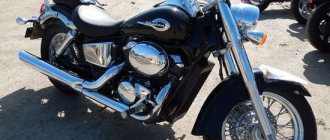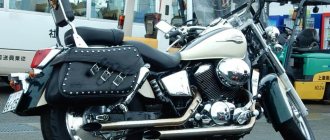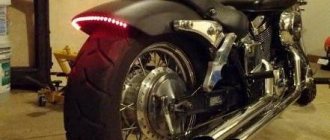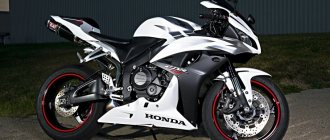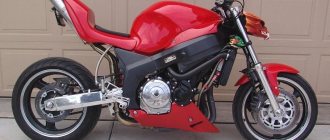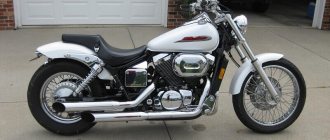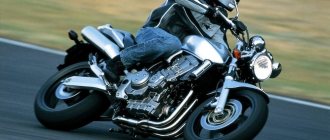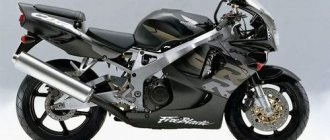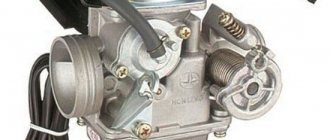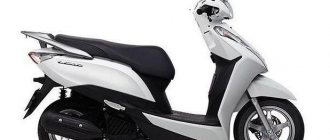It is not without reason that the Honda CB 600 Hornet motorcycle, perfectly balanced in all respects, has become so popular that it still has a whole army of fans, despite the fact that the last copies of this model rolled off Japanese assembly lines back in 2012. Having survived two serious upgrades, the Honda SB 600 stayed afloat for 14 years! However, judging by the reviews of the owners, who unanimously speak of unsurpassed reliability, the Hornets will be traveling on the roads for a long time. In addition, their technical characteristics allow them to compete on equal terms with more modern bikes. These days, motorcycles are built by marketers, not engineers, so the Honda CB 600 is one of the last of the true ironclad classics. More maneuverable and lighter than the “liter”, and two heads superior to the “four hundred” in all respects, it is definitely very good.
000_moto_0411_030
Honda CB600F Hornet: roadster, 2011, 600 cm³, 102 hp, 200 kg, 406,000 rub.
Honda CB600F Hornet: roadster, 2011, 600 cm³, 102 hp, 200 kg, 406,000 rub.
Hornet, or in our language - “hornet”, gained unprecedented popularity in Europe immediately after its debut back in 1998. A fast, light and angry motorcycle has replaced the “dinosaur” - the CB750. The heavy and clumsy machine with an air-cooled engine was morally and physically outdated, and the public accepted the new device with a bang. Since then, for 13 years now, the “hornet” has continued its flight across Europe and the world, renewing itself and becoming younger year after year.
At first glance, the updates may seem insignificant, but let's take a closer look. The appearance of the motorcycle has become more restrained and smooth, without losing either its characteristic “excitement” and aggressiveness, or its recognition. The ornate composite shapes of the “tail” and “muzzle” received a more holistic and harmonious appearance. The instrument panel, which “stuck out” above the headlight in its predecessor, like a chaga mushroom on a birch stump, is now made in a single body with the headlight, and the light device itself has received a “proprietary” Y-shape. Now there are no “feathers” - fairings that stuck out on the sides of the “Hornet-Third” on the sides of the “muzzle”. And the dashboard itself has changed. Instead of a large triangle with two LCD displays and an analog tachometer, a rectangle of an LCD screen appeared at the head. A small area houses a digital speedometer, fuel level and engine temperature indicators, a clock and, along the top edge, a tachometer slider. There is also an average fuel consumption indicator, which can operate both in the “kilometers per liter” mode and in the more familiar “liters per 100 km” mode. It was surprising that such a seemingly “touring” option appeared on a completely urban motorcycle, but it was not on the VFR1200F that debuted last year. But in motion, the compact instrument panel turned out to be not very readable. And if the speed readings and smaller numbers of the coolant temperature indicator are clearly visible, then the digitization of the tachometer scale is so small that even people with excellent eyesight are almost impossible to see it. You have to navigate “by touch” - by the general position of the end of the slider on the scale. Plus, the convex plastic of the instrument body is not covered by a visor and glares even in the absence of sun and from almost any viewing angle.
The “tail” has undergone changes according to the same principle of laconic form as the front part. Instead of a pile of passenger handrails on top of plastic and a massive “undertail” with turn signals and a platform for a license plate, the “Hornet” now sports a completely appropriate “tail” - smooth and rounded. The same fresh “corporate” Honda motifs as on the VFR1200 and Fireblade are visible in the form of plastic. The comfort and safety of the passenger have not been forgotten - instead of protruding handrails around the seat, there are now just comfortable and “graspy” recesses in the lower part of the tail plastic. Holding on to them is perhaps even more convenient than holding on to “handles.” True, securing a backpack or helmet with a luggage net-spider is now problematic. The point is not so much that the niches in the plastic are not so convenient for hooks, but that the plastic will inevitably be scratched from contact with the metal of the hooks. So now all the luggage is either behind your back or in the trunk (which, by the way, is not included in the line of branded accessories). The implication, apparently, is that a pannier is not suitable for a city naked bike, so you will have to look for “suitcase” options from alternative manufacturers. But there are plenty of all kinds of baubles that “don’t affect the speed, but look beautiful” in the catalogue, from stickers on the tank “carbon-look” and white rims for rims to a hugger and additional “undertail” plastic in the color of the motorcycle. There is also a “sports” cover for the passenger seat - after all, it is known that city “truck racers” do not give rides to passengers. In general, anything for a young, hot and attention-hungry soul. With an eye on the same theme, a new bracket for the license plate and turn signals was made. It has become much thinner and more elegant than its predecessor - a kind of sting. Naturally, the “sting” is easy to remove by unscrewing a couple of bolts, and then the Hornet takes on the appearance of a completely “hellish”, and not entirely legal (no number) streetfighter.
Honda undoubtedly understands that along with the growing desire to look cool, the level of driving skill of potential buyers is also growing. And in general, the cotton “classic” is CBF, and the Hornet is an “evil naked”, and “the boys won’t understand.” So now the Hornet is equipped with suspension adjustments so that the “guys” can competently discuss such lofty matters as the number of clicks in their “fighter” parties. The adjustments are not “complete” (so that a novice “racer” does not get confused), but they are quite enough to adjust the motorcycle “to suit you” for city riding. The cartridge fork received adjustments for spring preload and rebound hydraulics, and the shock absorber, in addition to the already familiar seven-stage spring preload adjustment, acquired rebound adjustment. You can’t become a true sportsman with such “wealth”, but for the city it’s more than enough.
The 180 rear cylinder is somewhat confusing. Why would there be such a skating rink on the “six hundred”, and what’s more, quite “peaceful”? Just remember the “liter” CBF, where the rear wheel has a much more modest 160th cylinder, despite the fact that the power of the “cousins” is comparable (but the “liter” has a third more torque, and 160 mm is enough!). A check for lice showed that a thick “donut”, although not an urgent need for the Hornet, is quite a pleasant addition. Thanks to the large contact patch, the lightweight machine holds the road perfectly and remains stable at any speed available to it, while there is absolutely no feeling that the motorcycle is “rolly” or hard to corner. By the way, the speed capabilities of the car were also surprising. On the highway, the Hornet's speedometer showed 221 km/h. And if you dress not in textiles with many pockets, flaps and folds, but in a more aerodynamic “pork”, you can reach 230 km/h. Not a bad result at all for a naked “six hundred”! Of course, it takes quite a long time to wait for numbers from the third hundred on the speedometer, and the complete lack of wind protection (the inclined surface of the headlight does not count) is not conducive to such exercises - it seriously blows your head off. But the very awareness of such a possibility, whatever you say, is pleasant. The “practical ceiling” of a machine is limited by the level of pumping of the neck muscles of a particular rider, his build and the selection of a helmet. Even a slightly worn “hat” negates all the efforts of the deltoid and latissimus dorsi muscles, elegantly smearing across the nose at speeds “up to two”. In a word, naked, he is naked. Designed not for speed records, but for shooting out of traffic lights and snooping between cars.
Here lies another paradox. The Hornet engine, as you know, came from a slightly derated CBR600RR power unit. In practice, Hornet has a character more suited to a “bumblebee” than a “hornet.” At first we accelerate smoothly and slowly, but once we accelerate, nothing can stop us! The engine confirms that it really has more than a hundred “horses” only at speeds close to peak. Up to 6000 rpm it is soft and fluffy politeness itself. At this mark the engine begins to wake up, and only after 8000 does it gain the expected pep, remembering that its family includes purebred racers. In a word, the high-riding nature of the engine does not really fit with its urban purpose, where the “fat middle” is much more in demand. On the other hand, Honda is positioning the Hornet as an entry-level and mid-level motorcycle, and beginners need the bike to be obedient and not have the habit of smearing its brain on the back wall of the skull at the slightest turn of the throttle. Like, do you want to finish the first season without incident? Please, here's a teddy bear for you. Do you want him not to get bored by the end of the second? Please keep the tachometer slider closer to maximum.
RESULT. I don’t want to seem like a sybarite, and I certainly don’t profess, like some, the religion “anything less than a liter is not a motorcycle.” To be honest, after a four-month break from driving, it was very difficult to bludgeon along the test route, which runs mainly along mountain serpentines, but the Hornet and I coped with the pace set by the Honda testers. I won’t speak for myself, because it’s not for me to judge, but the fact that Hornet did everything to make me feel confident on a difficult, unfamiliar road is a fact. The fourth Hornet turned out to be a truly balanced and technically polished car for every day. And from the outside, the device now looks like anything. Especially if it's yellow.
Reviews from Honda CB 600 Hornet owners
When I looked at Hornet for the first time, I immediately thought “how healthy he is, how can I handle him?” After the first trip, the doubts passed, as soon as you set off, the moto begins to steer like a feather, the turning radius is like that of a moped, the blast is brutal from the bottom, I didn’t even expect this from a six hundred. Then I rode a liter Hornet - so the 600 is better, it weighs less, but rides no worse, it’s even meaner, the liter will be calmer. Arthur, Moscow, Honda CB 600 Hornet '2005.
My Hornet died a heroic death in an accident, but only the most positive memories of him remain. I bought it used, with a mileage of 20k, probably worn out, I drove 60+ thousand, without any breakdowns, except for a burnt out clutch and a knocking fork. A motorcycle for all times. Sergey, Maykop, Honda CB 600 Hornet '2001.
A true brutal classic, the third generation is no longer the same, it’s kind of faceless, but the first two are fire! I had both, the first Hornet was from 1998, but it didn’t stay with me - it was stolen, then I bought a second one, made in 2006, and drove it until 2014, when I switched to a Dumbbell from BMW. I can’t vouch for the mileage at the time of purchase, but personally the motorcycle covered 110 thousand km under me, traveled from St. Petersburg to Tenerife, and to Lake Baikal, and traveled around half of Europe. You can travel with a passenger, but it’s better to travel long distances alone, panniers + topcase + passenger seat, and you can go even to the ends of the earth. I ended up selling Hornet only because I wanted a touring bike. Igor, St. Petersburg, Honda CB 600 Hornet '2006.
005_moto_0411_030
Three-piston calipers are installed on the version with ABS, but only the outer pistons “work” from the lever on the steering wheel.
The central one is operated by a pedal. In general, the braking system lacks information content, especially on the lever. Traditionally, for roadster and sports cars, the rear brake is ineffective. Three-piston calipers are installed on the version with ABS, but only the outer pistons “work” from the lever on the steering wheel. The central one is operated by a pedal. In general, the braking system lacks information content, especially on the lever. Traditionally, for roadster and sports cars, the rear brake is ineffective.
What kind of motorcycle is this anyway?
The first Honda Hornet motorcycles began to be sold back in 1998
, and today there are still good examples among them that are not a shame to buy.
But, it is advisable to take something fresher. The engine is a slightly reworked and throttled engine from the CBR600RR
. It has proven itself to be the best, truly reliable and powerful.
Frame of the Hornet
, which is how
“Hornet”
, is relatively simple, made of aluminum alloy, therefore lightweight and durable. Externally, the motorcycle looks modern and aggressive, even if we talk about its first modifications.
A good frame, engine, suspension and design - it is because of this that the motorcycle has become really popular, and today it can be seen at any motorcycle rally.
To date, production of the motorcycle has not been suspended; it continues to be produced, but somewhat updated. Periodically, the bike was modernized, but the changes were minor.
In 2000, it was decided to remove the 16-inch front wheel and replace it with a seventeen-inch one.
.
After that, the engineers touched the tank of this motorcycle - it was increased to 17 liters
.
In 2007, the manufacturer decided to update the power unit by modernizing it, which immediately affected the technical characteristics. The power system was replaced, the ignition system was improved, and the design was also not left without attention. So far, the last processing was carried out in 2009
, and the appearance of the bike remains unchanged to this day.
One gets the impression that the manufacturer did not want to change anything in the appearance of this motorcycle, but was determined to make it modern and as comfortable as possible.
I heard several times that improvements were made to the suspension, steering and riding position.
007_moto_0411_030
The fourth Hornet turned out to be a truly balanced and technically polished car for every day.
The fourth Hornet turned out to be a truly balanced and technically polished car for every day.
TECHNICAL SPECIFICATIONS Honda CB600F Hornet (manufacturer data)
| COMMON DATA | |
| Model year | 2011 |
| Wheelbase, mm | 1435 |
| Curb weight, kg | 200,4 |
| Length × width × height, mm | 2150×740×1075 |
| Ground clearance | 135 |
| Seat height, mm | 800 |
| Gas tank volume, l | 19 |
| Steering column tilt angle, degrees. | 25 |
| Reach, mm | 99 |
| ENGINE | |
| Type | R2, 4T |
| timing belt | DOHC, 4 valves per cylinder |
| Working volume, cm³ | 599 |
| Dimension, mm | 67×42,5 |
| Compression ratio | 12:1 |
| Supply system | fuel injection PGM-FI |
| Cooling system | liquid |
| Starting system | electric starter |
| Max. power, hp at rpm | 102/12000 |
| Max. torque, Nm at rpm | 63,5/10500 |
| TRANSMISSION | |
| Clutch | multi-disc, oil bath |
| Transmission | 6-speed |
| main gear | chain |
| CHASSIS | |
| Frame | spinal, aluminum alloy |
| Front suspension | inverted cartridge telescopic fork with adjustable spring preload and rebound hydraulics |
| Pipe diameter, mm | 41 |
| Stroke, mm | 120 |
| Rear suspension | pendulum, with hydraulic shock absorber, adjustable spring preload and rebound hydraulics |
| Stroke, mm | 128 |
| Brake system | hydraulic semi-combined C-ABS (braking of both wheels from the steering lever), with ABS |
| Front brake | 2 discs Ø 296 mm, 3-piston caliper (2-piston in version without ABS) |
| Rear brake | 1 disc Ø 240 mm, 1-piston caliper |
| Wheels | aluminum cast |
| Front tire | 120/70 ZR17, tubeless |
| Rear tire | 180/55 ZR17, tubeless |
Motorcycle test organized.
STR equipment is provided by the online store 4-moto.ru.
Hornet Episode 4: Honda CB600F Hornet
Pros and cons of the Honda CB 600
Advantages
- Excellent balance in all respects.
- No problems finding consumables, spare parts and tuning .
- Unsurpassed reliability . On the forums of SB 600 Hornet owners there are plenty of examples of motorcycles that have traveled hundreds of thousands of kilometers without any serious problems.
- Strong brakes that stop the bike effectively. This is especially noticeable on the 3rd generation CB 600F with ABS.
- Capacious gas tank - 16, 17 or 19 liters depending on the generation.
- Hurricane acceleration dynamics and a maximum speed of over 220 km/h.
Flaws
- The behavior of the motorcycle in the lower rev range is not the most stable - it reacts quite abruptly to opening the gas, which can be a problem for beginners.
- Lack of wind protection . You can install a windshield, which partly corrects the situation.
- Heavy weight . The curb weight of the Honda SB 600 Hornet falls just short of 200 kg.
Competitors
Despite its wide popularity, competitors were unable to clearly evaluate the model. Therefore, each of them released 2 models in order to at least partially achieve Honda’s capabilities:
Yamaxa
- Yamaha XJ6 Diversion . Steel frame, tourist class, production years 2009-2017.
- Yamaha FZ6N. 600 cc Fazer. Aluminum frame, naked class, produced from 2004 to 2009. Replaced by the 800 cc variant, which is also considered a competitor.
Suzuki . Two versions of the bandit.
- GSF 600 Bandit . Steel frame, road class, 1995-2004 Replaced with a more powerful version, which is also considered a competitor.
- GSR 600 . Aluminum frame, naked class, produced in 2006–2009.
Kawasaki did not stand aside. His couple of proposals featured larger engines.
- Kawasaki Z750. Steel frame, naked class, production 2004-2013. Engine capacity - 748 cm.
- Kawasaki Z800. Became a continuation of the previous one. Steel frame, class - naked, production 2013 - current time. Engine capacity - 800 cm3.
Model history
1998 - start of production and sales of the Honda Hornet 600. The first generation of the motorcycle. The model has a steel backbone frame and a 16′ front wheel.
2000 - The Honda Hornet 600 model is slightly updated, receiving a 17′ front wheel, a slightly longer wheelbase and a redesigned front fork. In parallel with the usual modification, the S version (with fairing) is produced.
2003 - second generation of the motorcycle. The Honda Hornet 600 gets a major update, with a slightly more modern design for both the bike and the dashboard. The fuel tank capacity increases by 1 liter (up to 17 liters), an inverted fork is installed instead of the usual one, the brake system is slightly updated (instead of the 2nd generation Nissin, the 3rd generation Nissin is installed), and a HISS immobilizer appears. The S modification is no longer offered for purchase.
Comparison of the Honda CB 600 F Hornet motorcycle with the Honda CBR600F4i
2007 - third generation of the motorcycle. The Honda Hornet 600 is being seriously updated both externally and technically. The appearance becomes similar to modern naked cars, the engine is now installed from the sports Honda CBR600RR (producing 102 hp), an injector is used instead of carburetors, the brake system is updated (a combined anti-lock braking system - C-ABS is optionally available), the fuel tank increases to 19 liters .
2012 is the last year of production of the Honda CB 600 Hornet model (official sales continued until 2013).
2014 - The Honda CB650F motorcycle was introduced as the official successor to the Honda CB 600 Hornet.
Driving performance
The developers announced a maximum speed of 225 km/h.
Users note that the power reserve is large. Surely it is possible to reach 260 km/h indicated on the speedometer, only the lack of wind protection hinders it.
Acceleration to hundreds
The dynamics are clearly reflected in the motor's sporting past. Acceleration to 100 km from standstill - 3.5 seconds .
Fuel consumption
Consumption is average for the class - 5.8 liters . During normal cruising (~ 160 km) on the highway it may be less than 5 liters. Specific numbers depend on driving style.
Flaws
In the 20 years since the model was launched into production, users have not found any serious problems.
Fans of long-distance driving note that the volume of the fuel tank does not correspond to their routes. But since the latter is a changeable quantity, this cannot be considered a disadvantage.
and dignity
The large, round and glass headlight shines quite adequately even with stock lamps.
There are quite a few advantages mentioned. The most frequently indicated:
- maneuverability;
- dynamics;
- fuel consumption;
- straightforwardness (although this depends on the person).
Design, fit, dynamics and, of course, safety and comfort - these are the qualities that describe this bike.
